
International Journal of AEROSPACE Psychology
metrics 2024
Connecting Minds with the Skies
Introduction
International Journal of Aerospace Psychology is a premier publication dedicated to advancing the interdisciplinary field of aerospace psychology, addressing the cognitive, emotional, and behavioral aspects of human interaction with aerospace environments. Published by Taylor & Francis Inc., this journal occupies a pivotal position in the academic landscape with its Q2 ranking in Aerospace Engineering and Q3 rankings in Applied Psychology and Computer Science Applications, reflecting its commitment to high-impact research. With an ISSN of 2472-1832 and E-ISSN of 2472-1840, it is accessible through open access options, ensuring that cutting-edge research reaches a wide audience of researchers, practitioners, and students. Covering a broad scope from psychological implications in aerospace systems to educational methodologies in this domain, the journal spans converged years from 2017 to 2024. The Scopus rankings further reinforce the journal's significance, with notable standings within multiple categories, making it an essential resource for those at the intersection of aerospace, psychology, and technology.
Metrics 2024
 0.41
0.41 1.00
1.00 1.30
1.30 52
52Metrics History
Rank 2024
Scopus
IF (Web Of Science)
JCI (Web Of Science)
Quartile History
Similar Journals
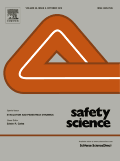
SAFETY SCIENCE
Elevating global safety standards through rigorous scholarship.SAFETY SCIENCE, published by Elsevier in the Netherlands, is a premier international journal dedicated to advancing the fields of safety research, public health, environmental and occupational health, and risk management. With an impressive impact factor and recognized as a Q1 journal in multiple categories for 2023, its rigorous peer-reviewed articles are essential for researchers, professionals, and students alike. The journal covers a wide range of topics designed to influence safety practices and policies globally. Although Open Access options are not available, the substantial insights provided in each issue underscore the journal's critical role in enhancing the understanding of safety and risk dynamics in a constantly evolving world. With a convergence of knowledge from the years 1991 to 2025, SAFETY SCIENCE remains at the forefront of evidence-based research, stimulating essential dialogues and innovations that shape our approach to safety in various domains.

BRITISH JOURNAL OF PSYCHOLOGY
Exploring Diverse Dimensions of the Human Mind.The British Journal of Psychology, published by Wiley, stands as a premier outlet in the field of psychology, reflecting its significant contributions to the discipline since its inception in 1953. Renowned for its rigorous peer-review process, the journal holds a prestigious Q1 ranking in the field of psychology and is positioned in the top 88th percentile among general psychology publications according to Scopus rankings. With an ISSN of 0007-1269 and E-ISSN 2044-8295, the journal provides a platform for cutting-edge research that spans a diverse range of psychological topics. Although it currently does not offer Open Access options, it continues to be an essential resource for researchers, professionals, and students eager to advance their understanding of psychological theories and practices. The journal's commitment to fostering academic discourse makes it indispensable for those looking to stay at the forefront of psychological research and application.
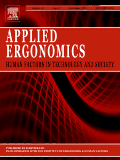
APPLIED ERGONOMICS
Elevating Safety Standards Through Applied ErgonomicsWelcome to Applied Ergonomics, a premier journal dedicated to advancing knowledge and practice in the multidisciplinary field of ergonomics and human factors. Published by Elsevier Science Ltd, this esteemed journal features a diverse range of research covering critical aspects of physical therapy, human factors, safety, and engineering. With an impressive impact factor and consistently ranked in the Q1 category across multiple domains—including Engineering, Human Factors and Ergonomics, and Safety—Applied Ergonomics serves as a vital resource for researchers, professionals, and students aiming to enhance user experience and optimize workplace safety. With its extensive historical archive dating back to 1969 and continuing through 2025, this journal encourages the dissemination of innovative applications and research findings that contribute to the ergonomics body of knowledge. For those interested in cutting-edge research that directly impacts health and safety practices, Applied Ergonomics is the authoritative source.
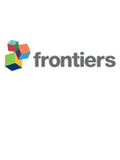
Frontiers in Psychology
Shaping the Future of Psychology TogetherFrontiers in Psychology, published by FRONTIERS MEDIA SA, is a leading open-access journal that has significantly contributed to the field of psychology since its inception in 2010. With an ISSN of 1664-1078, this prestigious journal is based in Switzerland and presents a platform for groundbreaking research covering a myriad of psychology subfields, including cognitive, developmental, and clinical psychology, among others. Holding a commendable Q2 ranking in the Psychology (miscellaneous) category for 2023, it is recognized for its high-quality publications, evidenced by its Scopus rank of #47 out of 216, placing it in the 78th percentile. The journal's commitment to open-access publishing ensures that research findings are accessible to a global audience, fostering collaboration and innovation in psychological research. By providing researchers, professionals, and students with the latest advancements in psychology, Frontiers in Psychology plays an essential role in shaping the future of the discipline, making it an invaluable resource for anyone engaged in psychological studies.

AEROSPACE AMERICA
Elevating Discussions in Aerospace Technology and PolicyAerospace America, published by the American Institute of Aeronautics and Astronautics, stands as a crucial platform within the field of aerospace engineering. With over 30 years of dedication to advancing aerospace knowledge, the journal provides a comprehensive exploration of topics ranging from cutting-edge aerospace technology to aviation policy and industry developments. While it currently resides in the fourth quartile of the Scopus rankings for aerospace engineering, the journal aims to enhance its visibility and impact among researchers, professionals, and students. Access to its content is traditionally through institutional subscriptions, aligning with its mission to foster informed discussions and innovations in aerospace. As professionals and academics navigate the evolving landscape of aeronautics, Aerospace America remains a pivotal resource for those committed to the future of aerospace exploration and technology.
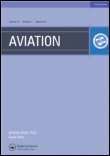
Aviation
Elevating aerospace knowledge for a brighter tomorrow.Aviation, published by Vilnius Gediminas Technical University, is a leading open-access journal dedicated to the dynamic field of aerospace engineering, with an ISSN of 1648-7788 and E-ISSN of 1822-4180. Established in 2004 and set to converge in 2024, this journal aims to disseminate high-quality research that advances the understanding and application of aerospace technology. With an impact factor reflective of its contribution to the discipline, Aviation ranks at Q4 in the Aerospace Engineering category and occupies the 80th position out of 153 in Scopus, highlighting its growing significance among scholarly publications. By providing free access to its content since 2018, the journal enhances its reach and encourages collaborative efforts in the academic community, catering to researchers, professionals, and students eager to explore innovative studies and findings within aerospace engineering. Based in Lithuania, this journal serves as a vital resource for those aiming to contribute to the future of aviation.

Behavioral Psychology-Psicologia Conductual
Elevating Psychological Practice Through Rigorous ResearchBehavioral Psychology-Psicologia Conductual is a pioneering journal dedicated to advancing the field of psychology, with a specific focus on clinical and experimental domains. Published by FUNDACION VECA PARA AVANCE PSICOLOGIA in Spain, this journal serves as a vital resource for researchers, professionals, and students seeking to explore contemporary practices and theoretical frameworks in behavioral psychology. With its ISSN 1132-9483 and E-ISSN 1132-9483, the journal has established itself over a span of nearly three decades, from 1996 to 2024, contributing significantly to the academic discourse. While it currently holds a Q3 ranking in Clinical Psychology and a Q4 ranking in Experimental and Cognitive Psychology as of 2023, it aims to promote knowledge synthesis and innovative approaches to psychological research. Despite the absence of an open-access model, the journal's rigorous peer-review process ensures the dissemination of high-quality research that resonates with the needs of a growing audience dedicated to enhancing psychological practice and theory.

Nature Human Behaviour
Illuminating the intersection of behavior and society.Nature Human Behaviour, published by Nature Portfolio in the United Kingdom, stands at the forefront of interdisciplinary research, connecting the fields of Behavioral Neuroscience, Experimental and Cognitive Psychology, and Social Psychology. With its commitment to publishing groundbreaking studies, this prestigious journal is categorized within the Q1 quartiles for 2023, indicating its elite status and significant influence in the academic community. Recognized globally with a remarkable Scopus ranking of #1 in multiple psychology and neuroscience categories, it showcases the highest quality research, thus appealing to students, professionals, and researchers alike. Despite being a subscription-based journal, its impactful scientific discourse continues to shape understanding of human behavior in social contexts. With the ambition to elucidate the complexities of human interaction and cognition, Nature Human Behaviour serves as an essential resource for anyone dedicated to advancing the realm of human behavioral sciences.

Journal of Health and Safety at Work
Bridging knowledge and practice in health and safety at work.The Journal of Health and Safety at Work, published by the Iranian Occupational Health Association, is a vital resource for researchers, professionals, and students engaged in the fields of occupational health, safety, and environmental management. With an ISSN of 2251-807X and E-ISSN 2383-2088, this Open Access journal has been dedicated to disseminating knowledge since 2012, ensuring that critical research is accessible to a global audience. The journal’s scope encompasses a diverse range of topics including human factors and ergonomics, safety research, and public health, with a focus on enhancing workplace safety and environmental standards. Although currently positioned in the Q4 category across various disciplines within safety and health research, the journal offers a unique platform for emerging studies and innovative practices, making it a significant contributor to the discourse in these fields. The journal's commitment to open access aligns with the growing trend of transparent scholarship, thus facilitating the sharing of vital insights to improve workplace health and safety outcomes. Researchers aiming to publish groundbreaking studies in this pivotal area will find the Journal of Health and Safety at Work an indispensable avenue for advancing knowledge and fostering professional collaboration.
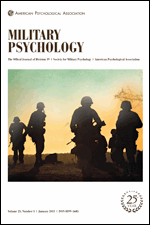
MILITARY PSYCHOLOGY
Exploring the psychology behind service and sacrifice.MILITARY PSYCHOLOGY is a premier journal dedicated to advancing the understanding of psychological principles as they apply to military settings and contexts. Published by ROUTLEDGE JOURNALS, TAYLOR & FRANCIS LTD, this esteemed journal has been at the forefront of military psychological research since its inception in 1990. With an ISSN of 0899-5605 and E-ISSN 1532-7876, it serves as a valuable resource for researchers, professionals, and students alike. The journal is classified in the Q3 quartile for both Experimental and Cognitive Psychology and Psychology (miscellaneous) in 2023, highlighting its significance in the broader psychological landscape. Additionally, it holds a commendable ranking within the social sciences, underscoring its relevance and influence in understanding psychological dynamics within military environments. Although it currently does not offer open access, the journal provides a wealth of insights into critical topics such as stress and resilience, operational effectiveness, and the mental well-being of service personnel, making it an essential read for anyone engaged in this pivotal field of study.